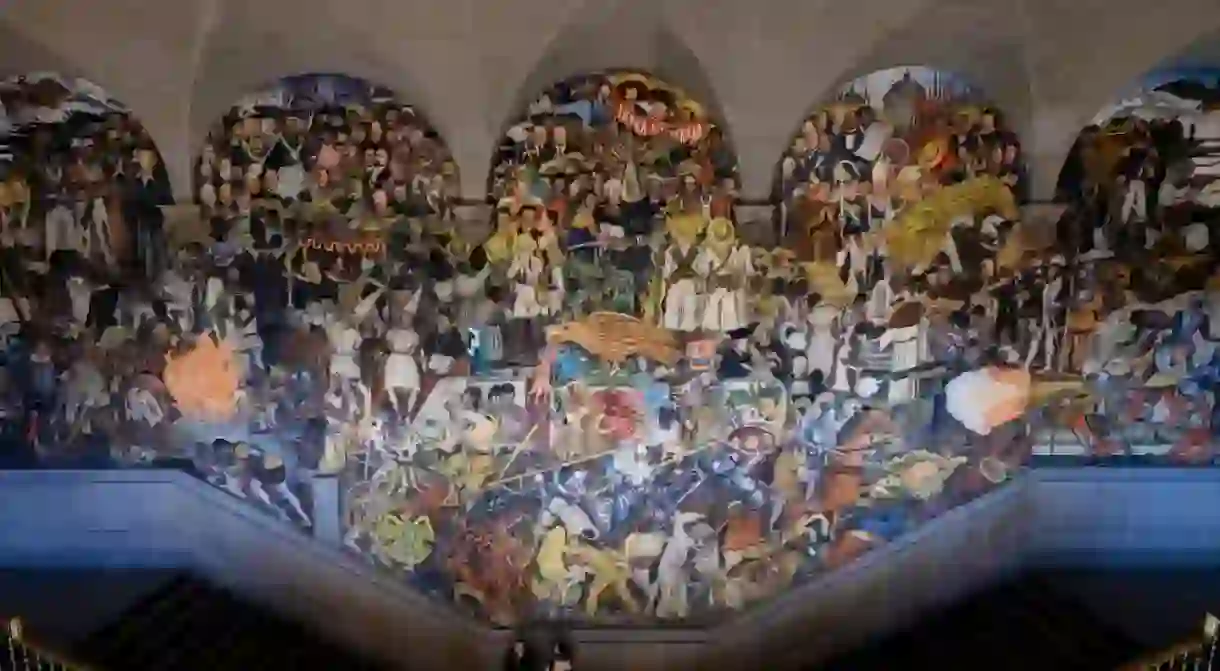The Art of Diego Rivera: A Tour Through Mexico City

Diego Rivera is revered and remembered as much for his iconic murals, paintings and sculptures, as he is for the pivotal role he played in preserving Mexico’s indigenous cultural heritage. A tour of some of Mexico City’s finest museums, palaces, houses and parks is the best way to see the fantastic range of Rivera’s artistic output.
Museo del Palacio de Bellas Artes
Museum

Palacio Nacional
Building, Ruins

Museo Casa Estudio Diego Rivera
Architectural Landmark, Museum
In 1929 Juan O’Gorman, the architect and friend of Diego Rivera, began building a studio and house, where Rivera and Frida Kahlo would live and paint some of their most famous works. The buildings are as striking now as they would have been then, combining elements of traditional Mexican architecture with functionalist design. The studio features artwork and tools used by Rivera, and houses an extensive collection of indigenous artwork collected by Rivera and Frida Kahlo. A virtual tour of the properties is possible thanks to the Instituto Nacional de Bellas Artes.
Museo Dolores Olmedo
Building, Museum
Museo Nacional de Arte (MUNAL)
Art Gallery, Museum
Museo Anahuacalli
Museum, Architectural Landmark

Diego Rivera was a great believer in the rich cultural heritage of Mexico, and over the decades amassed a vast collection of sculptures, paintings and artifacts. The bulk of Rivera’s collection can found in the museum he had built to house the Museo Diego Rivera Anahuacalli, which was finished after his death. The building draws on Aztec and Mayan architectural motifs, resembling a monolithic pyramid. Rivera maintained that his aim was to give back to the people as much of their artistic heritage as he could salvage. With over 50,000 pre-Hispanic artifacts, and an iconic museum that continues to promote Mexican artists, Rivera was true to his word and left the world an astounding legacy.
Cárcamo de Dolores
Museum, Architectural Landmark
The Cárcamo de Dolores, maintained by the Museo de Historia Natural y Cultura Ambiental, is part of the old waterworks system. It features a large mural by Rivera and a giant sculpture of the rain god Tlaloc. The mural was previously underwater, as the pool was a functioning structure of the city’s reservoir system, with the brilliantly colored images depicting scenes of fertility and the vitality of water were being slowly destroyed by the elemental force they portrayed. After much restoration, the fountain sculpture and the murals are now well worth the visit in Mexico City’s Chapultepec park.
Frida Kahlo Museum
Museum

The Museo Frida Kahlo, also known as the Blue House, was the house where Frida Kahlo was born, raised and died in, and was where she lived for a time with Diego Rivera. Along with artwork by Rivera, the house contains letters, drawings and possessions of the artist, as well as a series of interviews. It is impossible to get an overview of Rivera’s life without recognizing the importance of Frida Kahlo. The two artists influenced each other greatly, and the entire building is a monument to their work and creative life. Rivera’s presence can be felt throughout, from the hundreds of artifacts and paintings, down to the artwork and seashells embedded in walls by Rivera when he expanded the building.
Tours & Trips in Mexico
Natural Feature

Ready to explore some iconic sites and beyond? Check out these carefully curated guided tours, from Mexico City to epic adventures in Oaxaca and the coastal treasures of the Yucatan peninsula, these trips cater to every palate.













